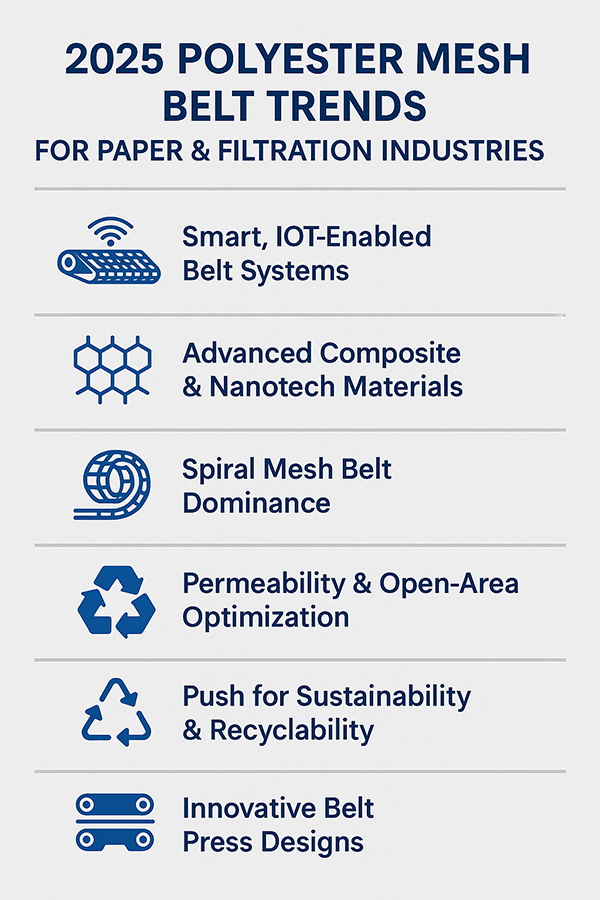
As we enter 2025, polyester mesh belts—crucial components in paper production, wastewater treatment, and industrial drying—are seeing accelerated innovation, driven by smart technology, material science breakthroughs, and environmental demands. Here's what's shaping the future of mesh belt applications:

Manufacturers are rapidly integrating IoT sensors and data monitoring into mesh belt operations. By capturing real-time data—such as belt tension, temperature, and vibration—these systems support predictive maintenance, allowing maintenance to be triggered by actual belt conditions, reducing unplanned downtime by up to 50%, and increasing mean time between failures by 30–40%.
Material science has ushered in composite belts and nano-enhanced coatings. These new belts offer:
* 40% longer lifespan.
* 15–20% higher dewatering efficiency.
* Abrasion-resistant and self-cleaning surfaces.
This translates to longer intervals between maintenance and more consistent belt performance.
Spiral-belt technology, especially in paper mills, is gaining momentum due to:
* Seamless, clipper-free construction that eliminates weak points.
* Robust structural stability under heat and mechanical stress.
* High permeability with effective filler yarns for moisture control.
These belts ensure reduced maintenance costs, seamless production, and improved paper quality.
Manufacturers now tailor belts with precise loop sizes and mesh counts to balance airflow, dewatering rate, and material retention. Composite spiral belts achieve **optimal open area** without sacrificing strength—crucial in sludge dewatering and pulp filtration applications.
As the industry seeks greener solutions:
* Eco-friendly polyester options, including recycled fibers, are on the rise.
* Nanocoated belts reduce cleaning needs and water usage.
* Durable belts mean fewer replacements and less waste.
Advanced filter press technologies include:
* Three-belt systems with differential speeds for handling dilute slurries efficiently.
* V-fold configurations offering compact layouts and high solids capture in small installations.
These configurations provide flexibility and efficiency across variable feed conditions.
* Cost Efficiency: Consolidated IoT-driven maintenance saves time and money.
* Process Improvement: Higher permeability and smarter material design enhance throughput and product quality.
* Durability: Advanced belt materials reduce wear and downtime.
* Compliance: Sustainable belt innovations support environmental goals.
* Full Plant Integration: Belt systems becoming part of overall digital control ecosystems.
* Material Innovation: Growth of hybrid belts for special environments.
* Customized Belt Design: On-site rapid prototyping through additives like nanotech coatings.
For the paper and filtration sectors, 2025 marks a significant leap in polyester mesh belt technology. With smart maintenance, next-gen materials, and tailored belt structures, the industry is set for greater efficiency, sustainability, and output quality.